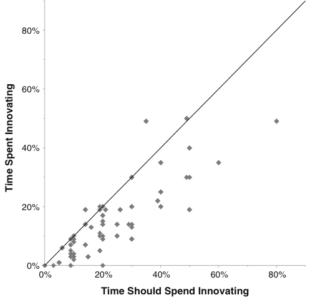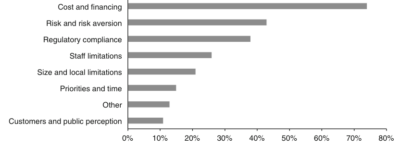Do water managers’ perceptions influence innovation?
New survey probes the innovation deficit
Climate change and population growth are rapidly increasing stress on our water systems, challenging their ability to deliver critical services. To respond to this, we need more than simple course adjustments in how we manage our water – we need entirely new paradigms that will improve resource efficiency and support more sustainable urban water systems.
Considerable work is being done to develop new visions for sustainable water infrastructure. Actualizing these visions, however, is another battle, one that requires increasing innovation in the urban water sector.
Sewage as a source of heat, energy and nutrients? Modular water recycling systems for buildings? Engineered wetlands as water treatment systems, flood management and new habitat rolled into one? Urine separating toilets?
These creative new concepts are challenging and complex to operationalize. And bringing these ideas to fruition must be done by our water, flood, and wastewater systems managers – collectively a sector that is widely, albeit mostly anecdotally, regarded as conservative and risk averse in its decision-making. They face little upside and significant downside when it comes to new approaches, which creates a bottleneck for innovation.
These observations beg the question: how do we accelerate the pace of innovation in the urban water sector?
Evaluating barriers to innovation: recent research
In spite of (or perhaps because of) its importance, innovation has become an overused (as well as loosely used) term, arguably in danger of losing its meaning. In our work, we define innovation as the development, application, diffusion, and utilization of new knowledge. We focus on the institutional factors that matter for innovation – the rules, norms, and conventions that influence decision-making play a crucial role in determining how innovation does and does not proceed.
We recently published a survey of wastewater utility managers in California. The survey was designed to assess the innovation deficit in urban water organizations and to identify means for supporting innovation. Our international group of collaborators conducted the survey in collaboration with the California Association of Sanitation Agencies.
The survey evaluated managers’ perceptions of innovative activity and the barriers and opportunities they face as decision-makers responsible for adoption of new technologies and management practices.
Key takeaways include the following:
-

Figure 5. Plot of reported time spent on innovation, versus amount of time respondent reports they should spend on activities related to innovation given the pressures facing their utility. The 1:1 line indicates answers where respondents report spending as much time as they think they should spend. See article for methods and details. Managers on the whole report spending relatively little time on activity related to innovation, which is expected by definition. But they also report spending less time than they think they should spend, given the challenges facing their utilities (Figure 5).
- Managers believe innovation holds promise for better water quality and reduced costs. However, they are much more optimistic about its long-term potential that its short term promise. This is important because the perception of limited relevance in and of itself may restrict long-term change.
- Managers have a skewed perception of their own innovativeness – they think they are more innovative than they actually are. Approximately 87% of managers reported that their organizations have average or greater innovativeness relative to other utilities.
- Key perceived barriers include cost and financing, risk and risk aversion, and the regulatory environment (Figure 7). Interestingly, managers reported feeling relatively unhindered by the organizations they represent, including feeling freedom to make their own decisions and relatively unhindered by their boards of directors or staff.

Figure 7. Barriers to innovation, coded from open-ended question. See article for details and methods.
There is a tendency to lionize risk takers and innovators in our modern society. So it is crucial to realize that the conclusions from this research should not be interpreted as personal judgements of the managers in this sector. Rather, it is an assessment of the lack of incentives and resistant conditions we have created for them to work in. It is those conditions that we study, and collectively can seek to change.
If the results from our work reflect broader realities in the municipal wastewater sector, they imply that systemic underinvestment in innovation cannot be resolved at the level of the individual agency or manager in isolation. Which makes it all the more pleasing to observe some emerging actions by industry groups such as the Water Environment & Reuse Foundation, forward looking regulators at the U.S. EPA’s Office of Water, and of course ongoing research at a number of institutions around the world.
Ultimately, stronger incentives for rapid innovation are needed at multiple institutional levels if we are to enable advanced urban water systems that can sustain and protect the next generation.
This post is based on a recent article, co-authored with and international group of collaborators from UC Berkeley, Stanford, eawag, and University of Utrechet under the ReNUWIt program. Subscription required, or please contact me for a copy:
Michael Kiparsky, Barton H. “Buzz” Thompson, Jr., Christian Binz, David Sedlak, Lars Tummers and Bernhard Truffer (2016). “Barriers to Innovation in Urban Wastewater Utilities: Attitudes of Managers in California.” Environmental Management 57(6): 1204-1216.
Reader Comments
3 Replies to “Do water managers’ perceptions influence innovation?”
Comments are closed.






Hi Michael,
Great post and a very interesting study. A few thoughts:
First, will you investigate the history and pace of water innovation in the private sector? Some industries deploy water recycling and efficiency technologies to lower their (short-term) costs. It doesn’t seem that there’s currently much knowledge transfer between private and public water systems, which might be an interesting issue to research.
Second, how could expanding the market for water technology offer new opportunities for innovation? I recently published a blog post exploring the idea of an upscale market for residential water reuse for drought-proof landscaping. Dubbed “the Tesla approach to water,” it was a provocative attempt to consider how a luxury consumer market could drive down costs of water reuse technology through increased deployment, learning curve effects, and reinvested R&D dollars – a la Tesla’s strategy to transform the car industry. I raised a number of issues with the idea, but remained optimistic that creating a market where there is less risk and more reward could open up space for water tech innovators. When the current market is for systems that cost tens of millions of dollars and protect the public health of millions of people, there is bound to be some risk aversion.
(In that vein, the Codiga Resource Recovery Center at Stanford is a very promising attempt to create such a space for technical testing and experimentation. It could be interesting to partner with them on the legal, regulatory and policy side).
Third, it’s unsurprising that the managers you surveyed identified costs and financing as a major obstacle. What is surprising, though, is the current research gap between water innovation and infrastructure financing. How is water infrastructure paid for? Largely with municipal bonds – a risk-averse market. (Ceres has published some excellent reports on the issue of water infrastructure finance, and the Environmental Finance Center at UNC Chapel Hill has too. NRDC’s Center for Market Innovation and NatLab did research along these lines as well, particularly on stormwater). We need additional research into how to finance innovations in water technology and the development of specific policy proposals. Importantly, this research, like that done previously by Ceres and NRDC, needs to be in-depth, technical, and actionable.
Lastly, what about the attitudes toward innovation on the part of the elected officials who govern public water systems? How might they converge or diverge from the attitudes of system managers? The WaterNow Alliance in San Francisco, which brings together water utility leaders and elected officials, and Sustainable Silicon Valley in Santa Clara, could be good partners in exploring this topic further and implementing any proposals by the Wheeler Water Institute.
Zach Miller
Sacramento, CA
J.D., UCLA School of Law
Zach – thanks for the thoughtful comments. We have some ongoing work that will touch on some but not all of the points you make, so stay tuned.
I would also refer to you some work by Newsha Ajami and her colleagues at Stanford that may touch on some of the points you bring up, although I expect not as directly or completely as you may want to see. E.g.,
https://woods.stanford.edu/sites/default/files/files/path_to_water_innovation_thompson_paper_final.pdf
https://woods.stanford.edu/sites/default/files/files/Funding%20Water%20Projects%20Whitepaper-FIN-WEB-02022016.pdf
Best,
Mike
Without true cost accounting and financial discipline by local government utilities any innovation will be for nought.